Hydrogen Peroxide Beyond First Aid: 40 Reasons To Always Have A Bottle At Home
Hydrogen peroxide is familiar to many, and all of us probably have it in our cabinet now. We usually think of it as a first aid kit necessity and use it to disinfect minor cuts and scrapes. Additionally, many of you know it’s good for your oral health too. But how many of you knew there are dozens of ways to use this handy product at home? While this product has been deemed safe, please always ask a doctor before putting it directly on your skin. Other than wound care, hydrogen peroxide has also proven to be a trusty cleaner around the house, and after reading this list, you might consider it a must-have in your beauty routine. Many of these hacks were totally new to us! Some will likely surprise you as well.
Sanitize Dishes
When it comes to food safety, it is important to sanitize kitchen utensils, surfaces, dishes, and other items that come in contact with food. This can help lower the possibility of germs and bacteria entering our system through the things we eat.
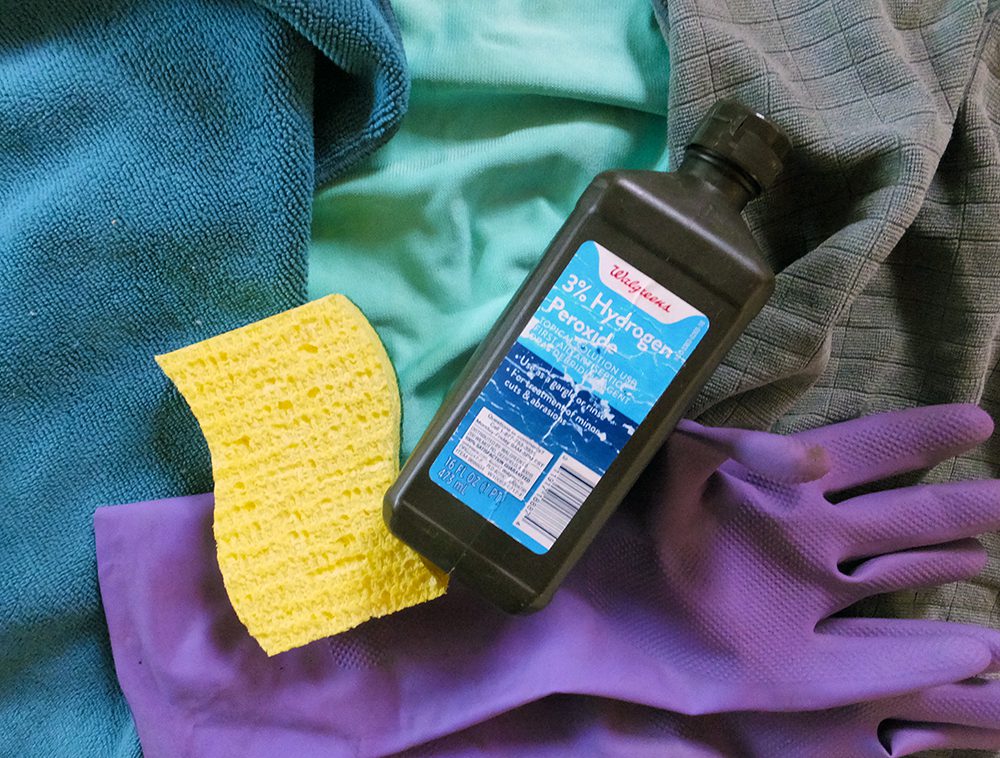
Germs and bacteria put our health at risk, which is why we should sanitize our dishes well. Mix two ounces of hydrogen peroxide with regular detergent and add that to your dishwasher; we recommend you do this regularly. You will definitely see the difference!
Clean Inside Appliances
As mentioned above, we should sanitize anything that comes in contact with the food we consume; this includes kitchen appliances like ovens, microwaves, and refrigerators. Because the insides of these gadgets aren’t cleaned frequently, they become a place where germs and bacteria like to “hang out.”
Cleaning the insides of kitchen appliances is rather easy; you only need to wipe down the insides with hydrogen peroxide. Since hydrogen peroxide is non-toxic, it’s safe to use to clean food storage, dishes, and cutlery, in case you were worried!
Clean Food Prep Surfaces
Other than that, food prepping surfaces should also be cleaned as we can’t see the germs and bacteria on these surfaces. And if they aren’t properly cleaned, the germs and bacteria could transfer to the food we work so hard to prepare.
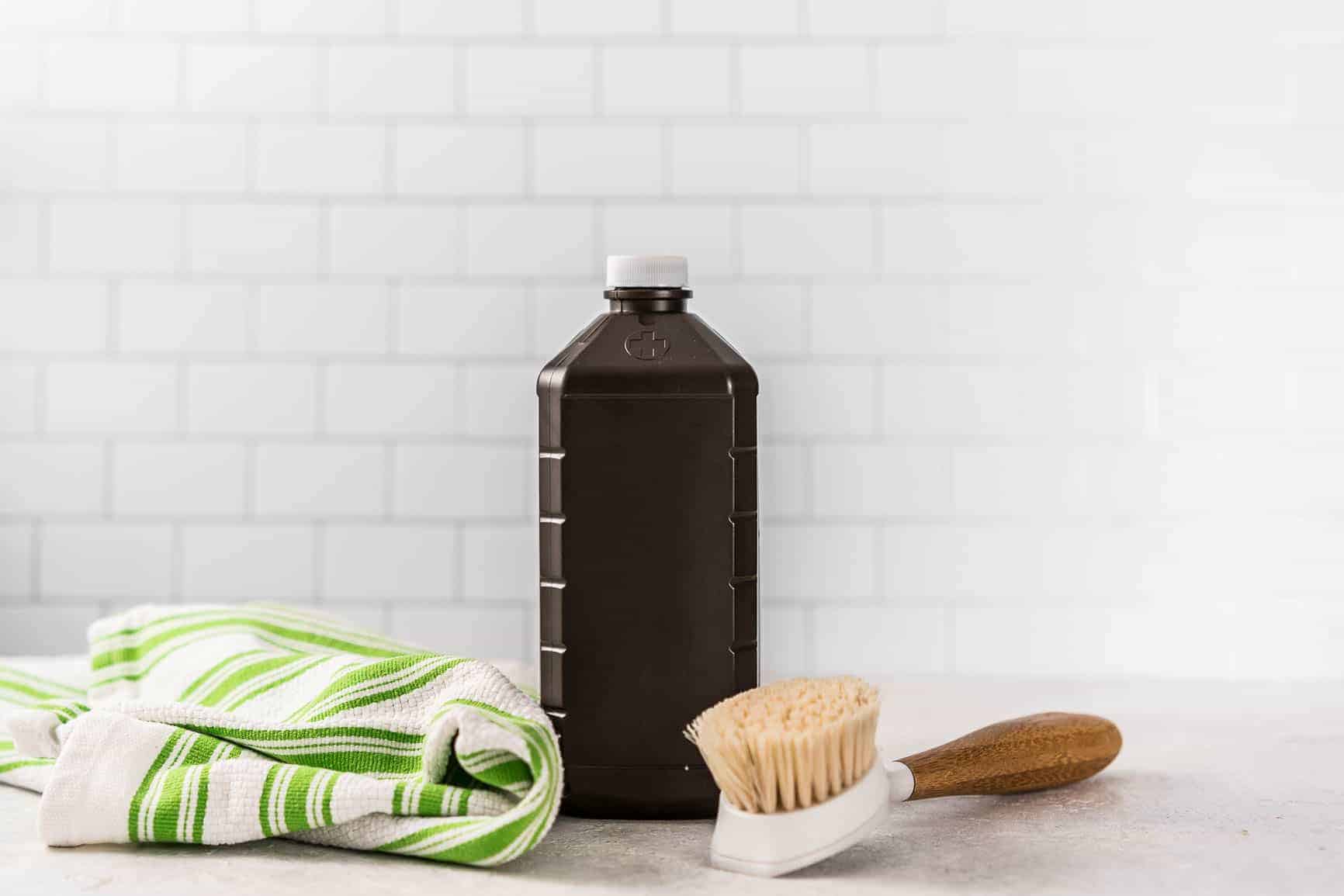
We should always clean our kitchen countertops and cutting boards before we use them. We all know this, but this is a great easy method: fill a spray bottle with hydrogen peroxide and spray the surfaces with it. Let it sit before cleaning with a scrub brush and rinsing it clean.
Sanitize Kitchen Sponge
It doesn’t matter if your kitchen sponge is used to clean filthy dishes or wipe down dirty tables. The sponge itself is filled with germs and bacteria that the human eye can’t see. It’s another kitchen item that we need to sanitize.
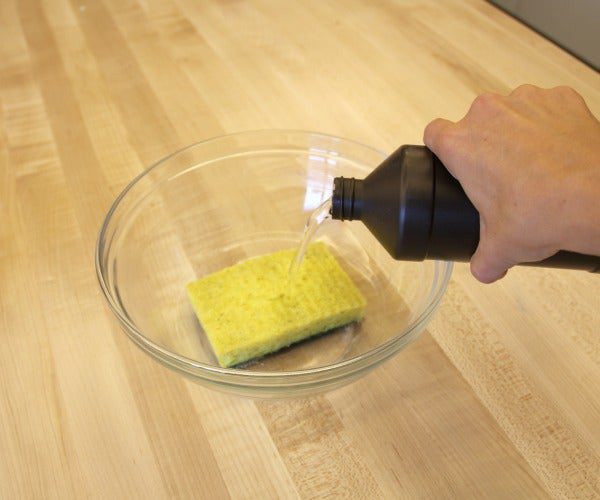
In a shallow dish, combine warm water and hydrogen peroxide (equal parts); soak the sponges in the solution for roughly ten minutes. Rinse them well and let them air dry. They will be as clean as when you first bought them.
Remove Stubborn Cookware Stains
Over time, your cookware will develop brown stains caused by oil and grease accumulation. You have probably already noticed you have a hard time scrubbing these stains off your pots and pans. They’re pretty difficult to get rid of.
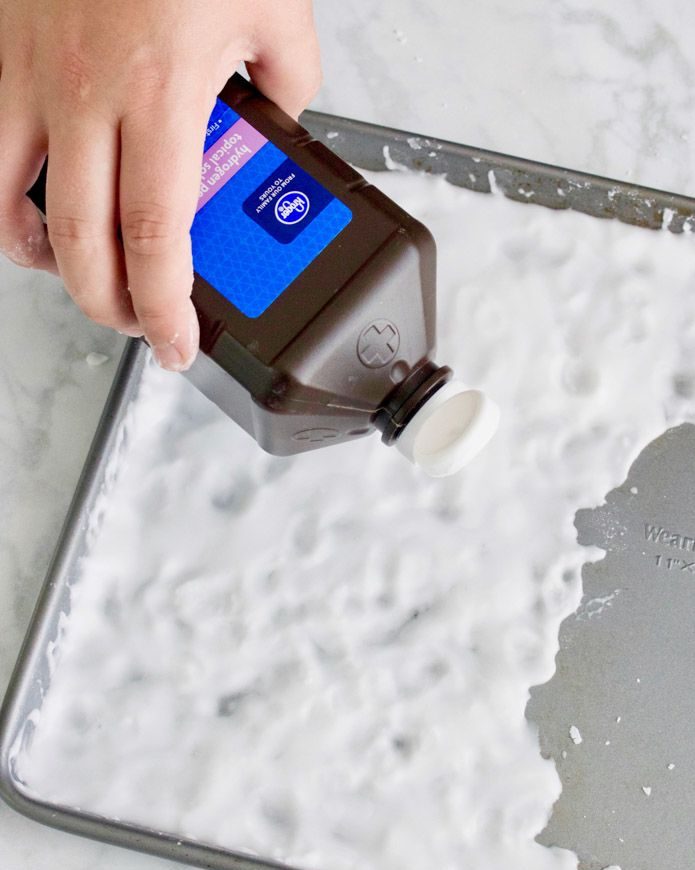
Fortunately, getting rid of the stains is made easier with the help of this hydrogen peroxide and baking soda paste. Apply a generous amount of paste onto the stain and let it sit for several minutes before scrubbing the cookware well.
Sanitize Lunch Boxes
Since lunch boxes are used to hold food, they should be cleaned and sanitized after each use. Since we often put packages of food in the bag, and don’t let our sandwiches roll around freely in there, we might not think about this that often.
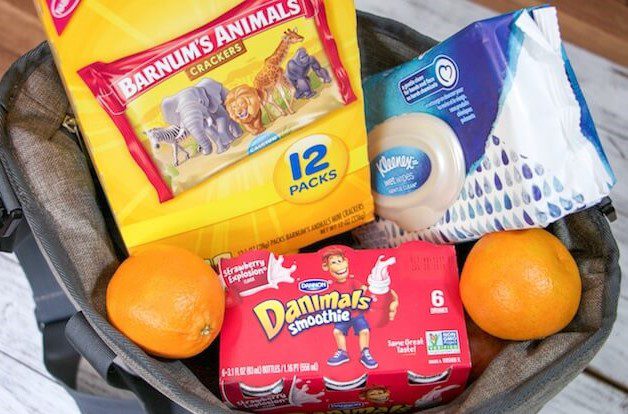
You can sanitize your lunch boxes easily by simply spraying them with hydrogen peroxide and wiping them with a clean cloth. While you’re sanitizing your boxes and bags, you should also do the same for your thermos or travel mug.
Clean Coolers
Other than lunch boxes, coolers are also used to hold food and drinks, but usually larger quantities of food for longer periods of time. It’s a good idea to clean your cooler after each use to ensure that it’s sanitized.
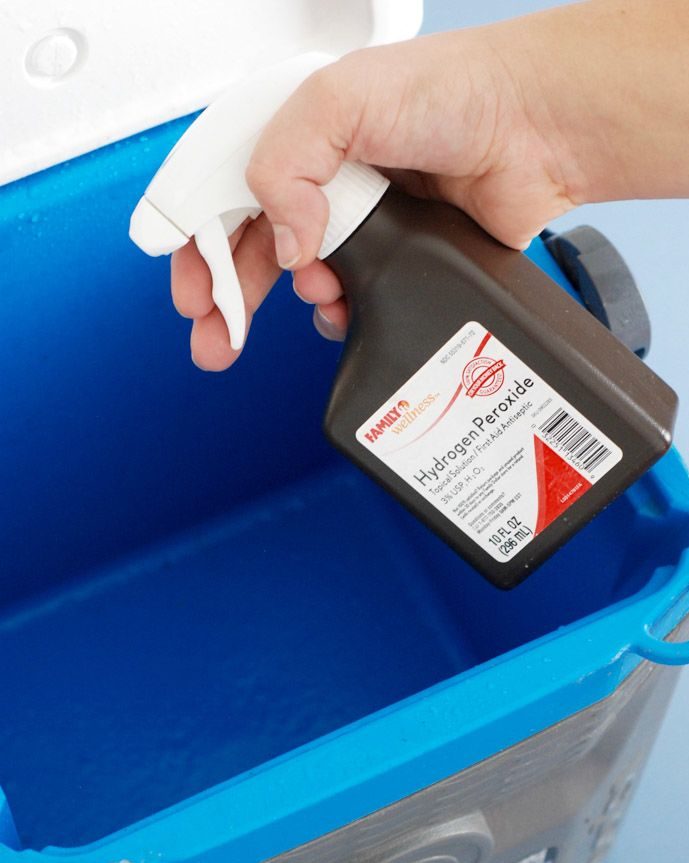
Again, hydrogen peroxide can be useful for this task; simply fill a spray bottle or attach a spray top to a bottle of hydrogen peroxide and spray the insides of your cooler or ice chest. After that, wipe them dry.
Sanitize Shopping Bags
It’s wise to sanitize shopping bags after grocery runs. Many people have touched our groceries before they come home with us, which is why it is recommended to clean the items you bought as well as what you transported them in.

Spray down the insides of your shopping bags with a bottle of hydrogen peroxide, and you’ll be bringing home groceries in a clean and sanitary bag; you can also spray down your groceries, mail, and even packages if you wish.
Washing Fresh Produce
Eating fresh produce is beneficial to our health, but it is often dirty whether you buy it from a grocery store or farmer’s market. It is important to wash fruits and vegetables free of pesticides, dirt, and germs before eating them.
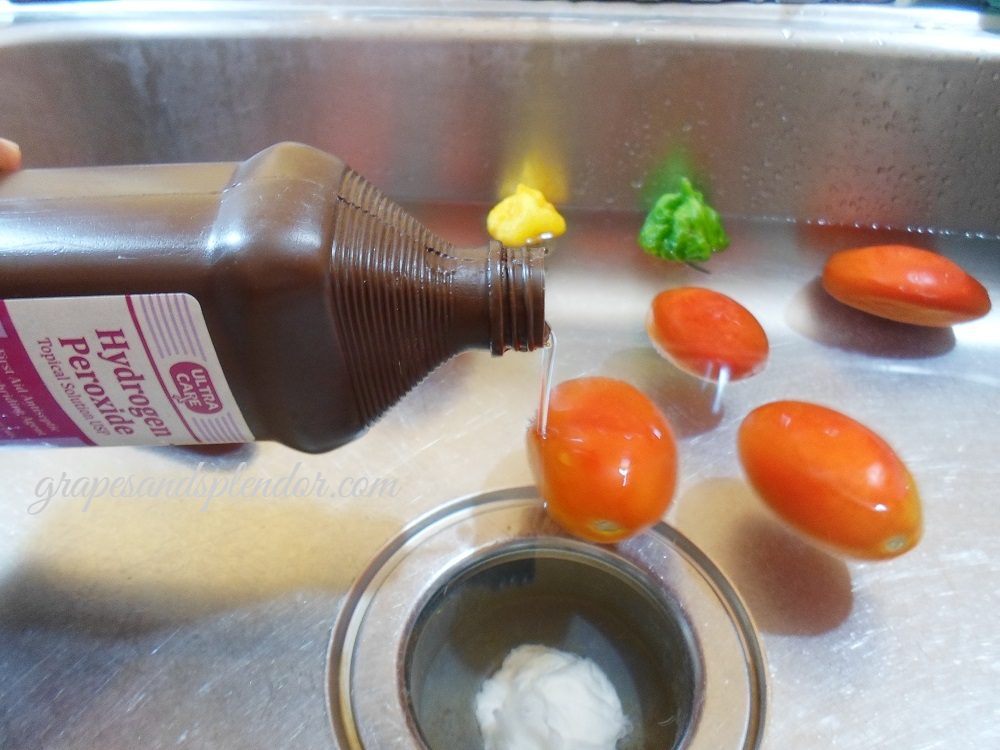
To wash fresh produce effectively and efficiently, fill your sink up with a few inches of water – enough to cover the fruits and vegetables. Add ¼ cup of hydrogen peroxide to a sink of cold water and thoroughly but gently scrub the produce. Rinse off when done.
Homemade Toothpaste
This hack is a classic that we always revisit. You can combine hydrogen peroxide and baking soda to create your own toothpaste; if you’re someone who yearns to have a set of white teeth, add some salt to the DIY toothpaste to give it teeth-whitening effects.
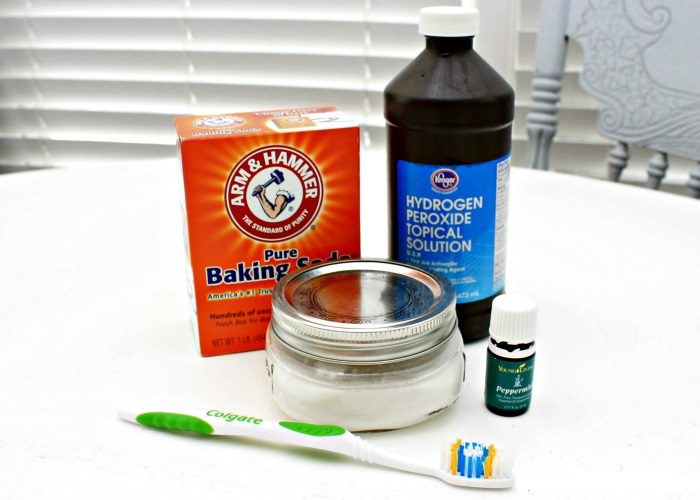
Not only can this homemade toothpaste give you whiter teeth, but it can also give you a healthier mouth overall. Hydrogen peroxide’s antibacterial, disinfectant, and antiviral properties effectively remove germs and bacteria and give you a fresher feel, and may lead to fewer dental problems.
Homemade Mouthwash
Of course, hydrogen peroxide can also be used as mouthwash that helps freshen breath. How does it work? As we said above, it has the effects of killing bacteria in your mouth that may cause halitosis, the official medical term for bad breath.
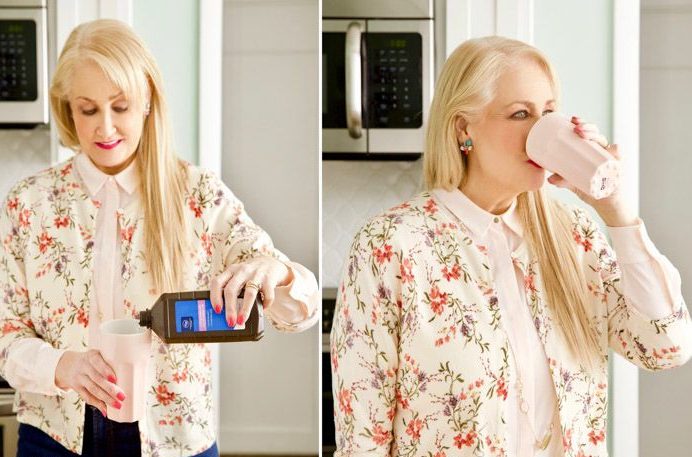
To make a hydrogen peroxide mouthwash, mix equal parts of water and hydrogen peroxide and swish it in your mouth for about a minute; you can make a small bottle of this that you can stuff in your bag and gargle whenever, wherever to get fresher breath.
Sanitize Toothbrush
Speaking of oral health, toothbrushes should also be cleaned. Toothbrushes come in contact with the food remnants in our mouth, which provides bacteria and plaque with energy to expand. When we don’t cover them, they also come in contact with germs and bacteria in the air.
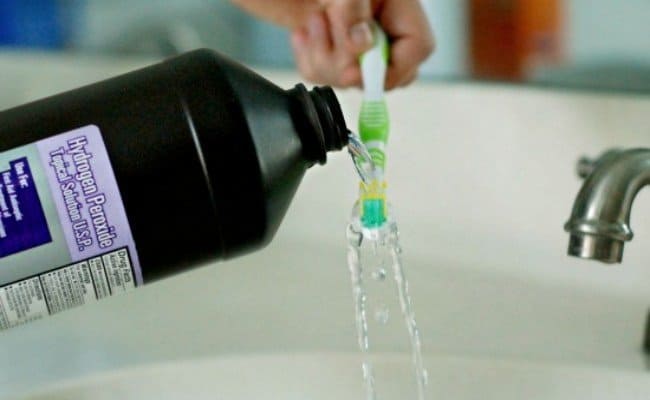
Therefore, it is a must to sanitize and switch out toothbrushes once in a while; sanitizing is especially important if someone in your home is sick or has been sick. To sanitize toothbrushes and kill any bacteria, simply soak them in hydrogen peroxide.
Clean Toilet Bowl
Toilet bowls may be the dirtiest item you own, and of course, we all can imagine why. You didn’t even need us to say it! Cleaning them regularly and sanitizing them in between deep cleanings should become a part of your routine.
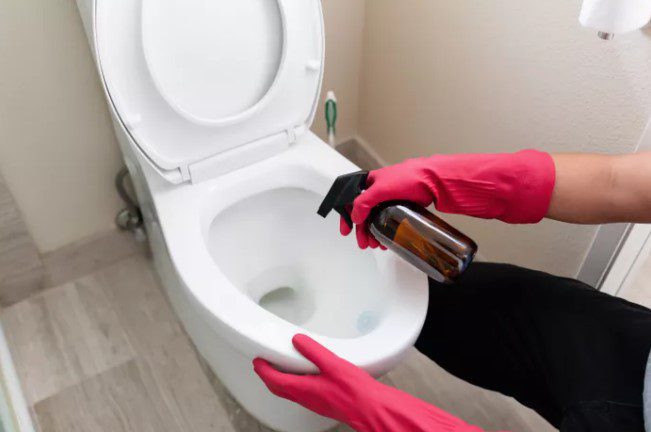
This can be done by pouring ½ cup of hydrogen peroxide down the toilet bowl and letting it sit for around 20 minutes before scrubbing it clean with a toilet brush. Needless to say, you can also pop a toilet bowl freshener once you’re done.
Bathtubs
Dissolved iron, as well as tannins in the water, may cause both brown and yellow stains in your bathtub after years of use. Unfortunately, there’s nothing we can do to prevent the formation of these stains, but we can clean the stains.
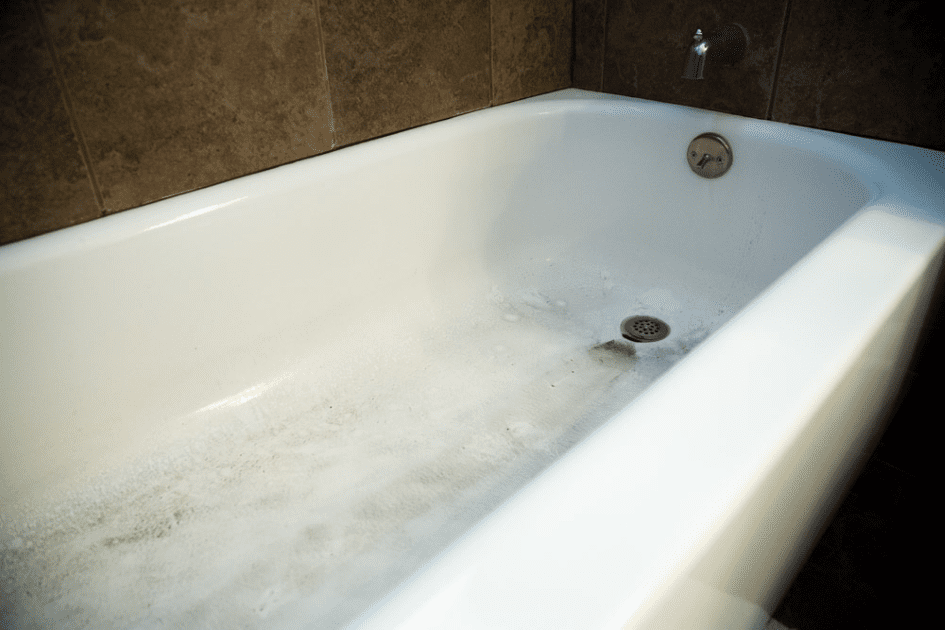
All you need to do is mix one part of hydrogen peroxide into two parts baking soda, forming a paste that you can rub on the stain. Leave the paste on for 30 minutes to an hour before wiping it off and rinsing the tub.
Showers
Similarly, germs, fungi, and bacteria can linger in showers, especially in showerheads. If you’re unlucky, you may catch infections from a dirty shower. A common infection you can get from a cruddy shower floor is athlete’s foot, which is itchy and uncomfortable.
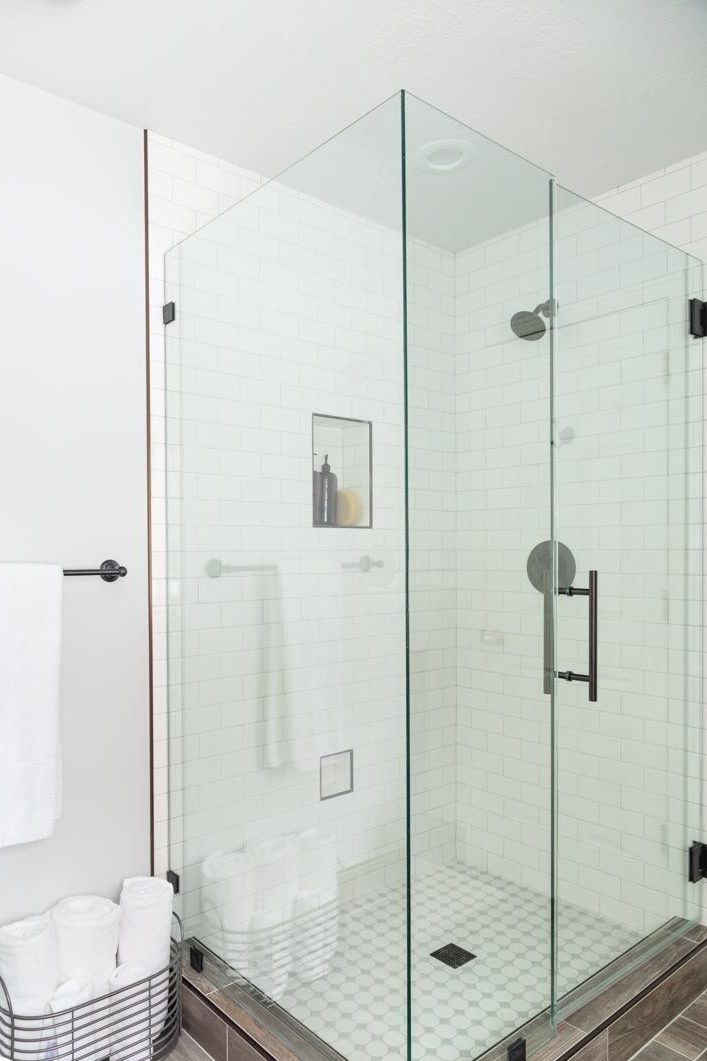
You can eliminate germs and bacteria from the showerhead by letting it run hot on full power for a minute or two from time to time; shower walls and floors, on the other hand, can be sanitized by spraying them down with hydrogen peroxide.
Bathroom Mold and Mildew
Mold and mildew need a damp and moist environment and organic materials to grow and thrive. Naturally, bathrooms, which are wet and humid much of the time, become the optimal breeding ground for all sorts of fungi (like mold).
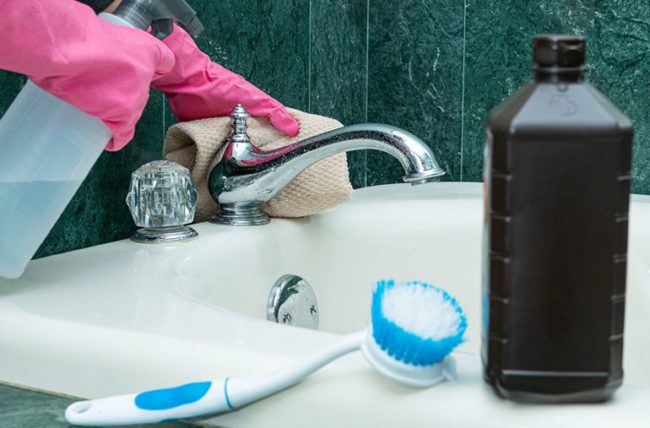
Hydrogen peroxide is the best mold and mildew eliminator as it’s effective, not to mention affordable. To remove problem spots in your bathroom, spray some hydrogen peroxide on the affected area and let it sit for several minutes before wiping it away.
Curtain Liners
Shower curtains come in contact with all sorts of steam, soap scum, as well as dust almost every day. If they aren’t cleaned periodically, there’s a chance that your shower curtains will become slimy and even turn brown after some time.
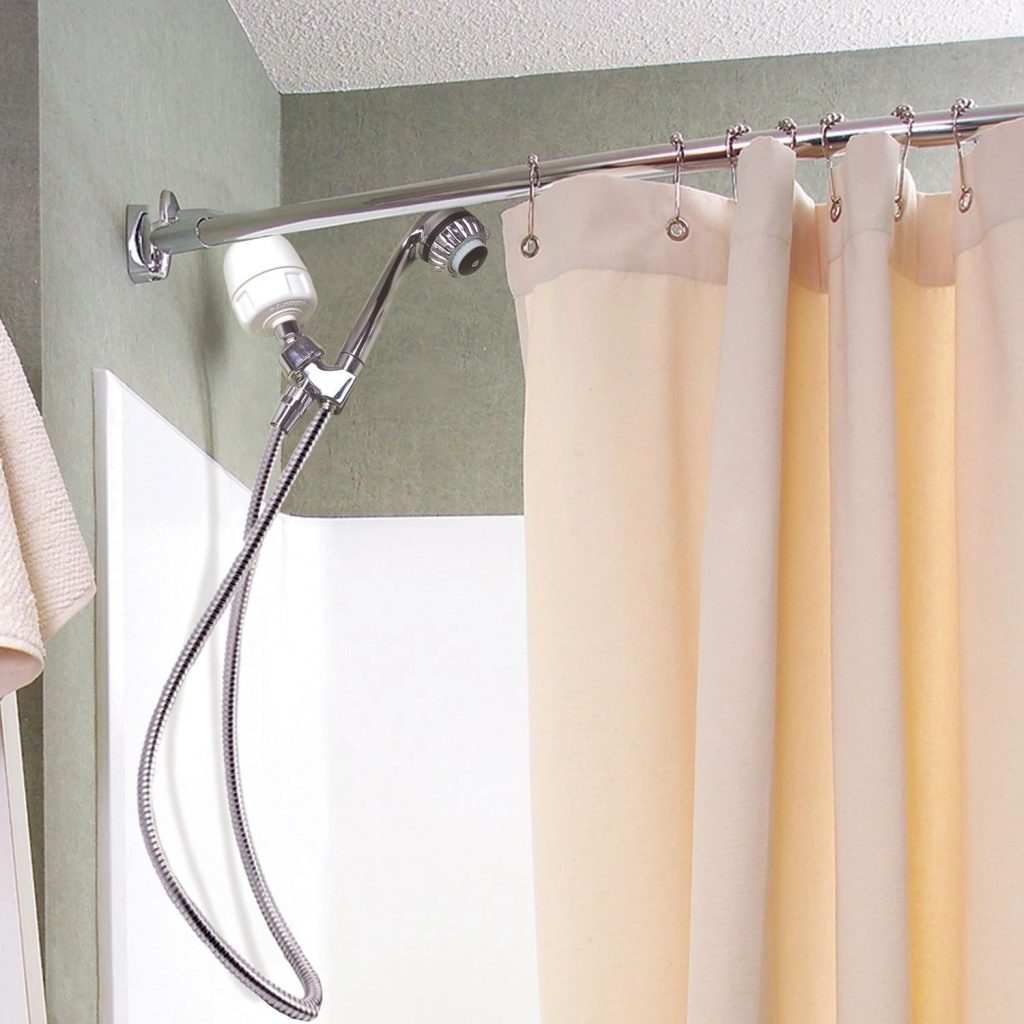
Nonetheless, this is a problem that can easily be solved with hydrogen peroxide; place your curtain liners along with a bath towel in the washing machine, add 1 cup of hydrogen peroxide to your regular detergent, and set the machine to rinse cycle. If your liners are plastic, lay it out flat and scrub with a mixture of hydrogen peroxide and baking soda.
Clean Glass and Mirrors
Glass and mirrors often get handprints, toothpaste, and watermarks on them. We’d have to wipe them away with Windex or something similar. However, cleaning glass and mirrors is a tricky business because we may leave streaks behind while we clean.
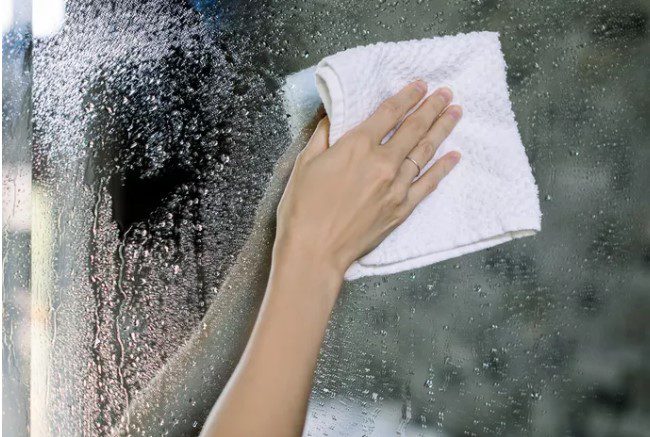
To avoid leaving streaks on your glass and mirrors while cleaning them, fill a spray bottle with hydrogen peroxide and use it as you would an ordinary window cleaning solution; you will be pleasantly surprised with how well this works!
Grout Lines
Because our houses are well-loved and lived in, the grout between our tiles gets dirty. Of course, you can clean it by “painting” over the lines with grout markers, or you could substitute this method with hydrogen peroxide, which does the job just as well.
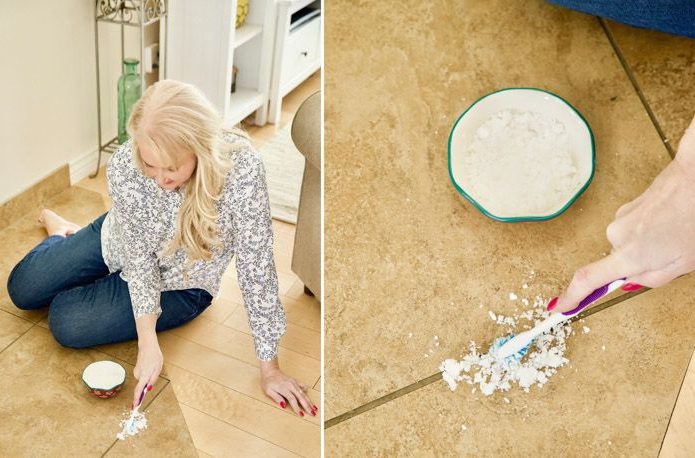
To clean and brighten the dirty grout, spray some hydrogen peroxide on each line and let it sit for some time. Then, come back to it with an old toothbrush and scrub diligently; the dirt should disappear in no time, leaving your grout brighter than ever.
Mop Floors
It wouldn’t make sense to have bright and clean grout but dirty floors, right? So, while you are cleaning the dirt from the grout, you can once again turn to hydrogen peroxide for help in getting clean and bright floors.
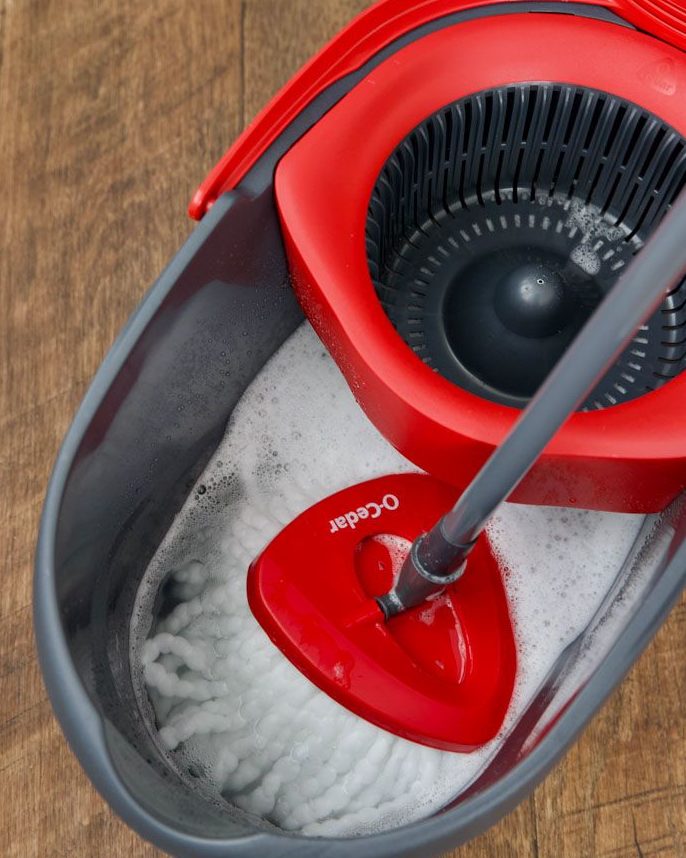
Simply add ½ cup of hydrogen peroxide to a gallon of hot water and mop your floors with it; this cleaning solution is so mild that it requires no further rinsing, which saves time. Once you’re done mopping, all you have to do is admire your work.
Clean Humidifiers
Humidifiers are lifesavers during the dry season; they release water vapor or steam to increase the moisture levels in the air, but how often do we think to clean our humidifiers? The truth is not that often, which allows bacteria and germs to lurk inside them.
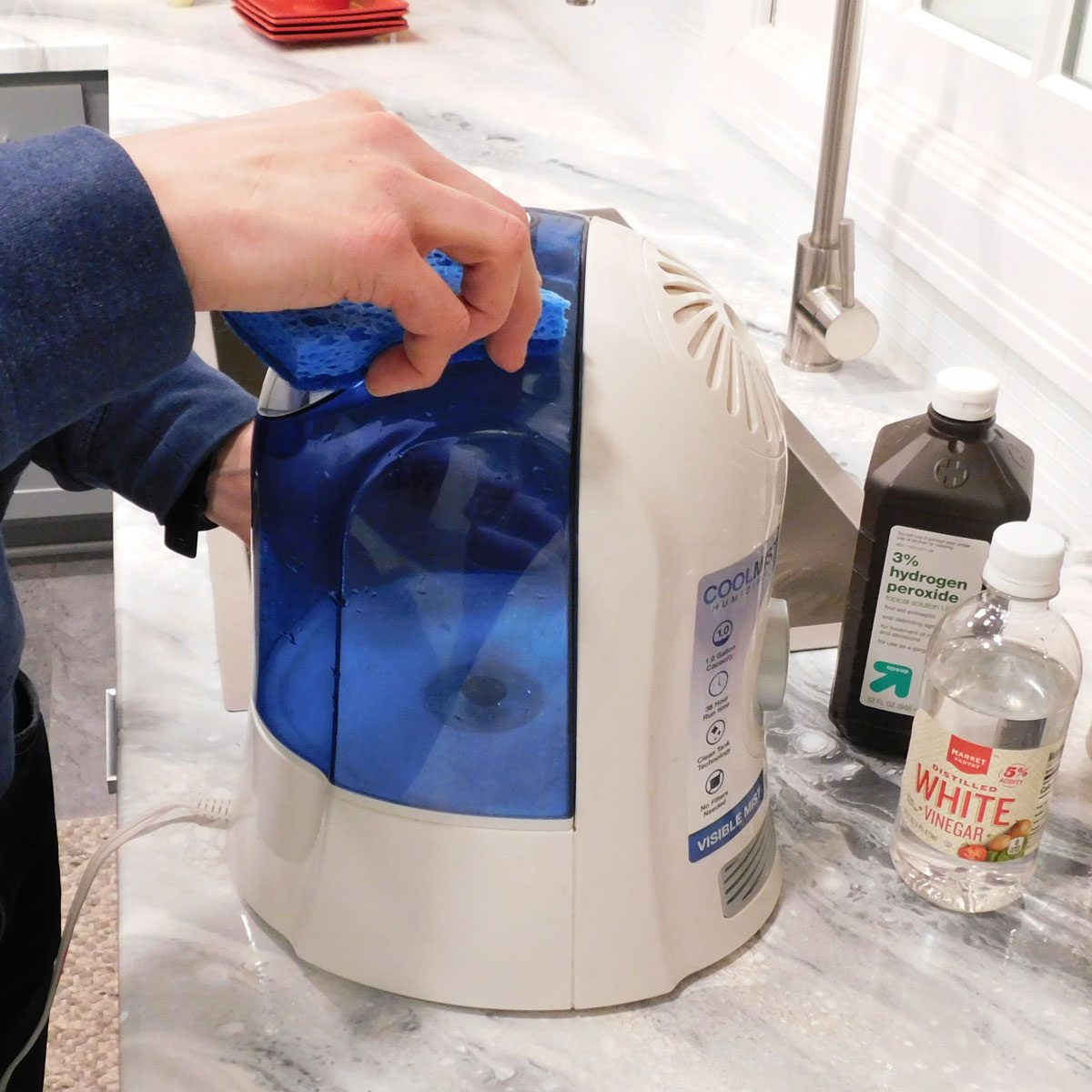
To prevent the growth of bacteria and germs in humidifiers, add a pint of hydrogen peroxide to a gallon of water and pour it into the tank of your humidifier. Leave it for roughly an hour. Then empty the humidifier, rinse it, and let it dry.
Fish Tank Fungus
Aquarium fungi is a common problem for fish owners who don’t clean their tanks often. Fungus left to “run rampant” can lead to infection in the fish. Therefore, it is important that fish tanks are cleaned from time to time.
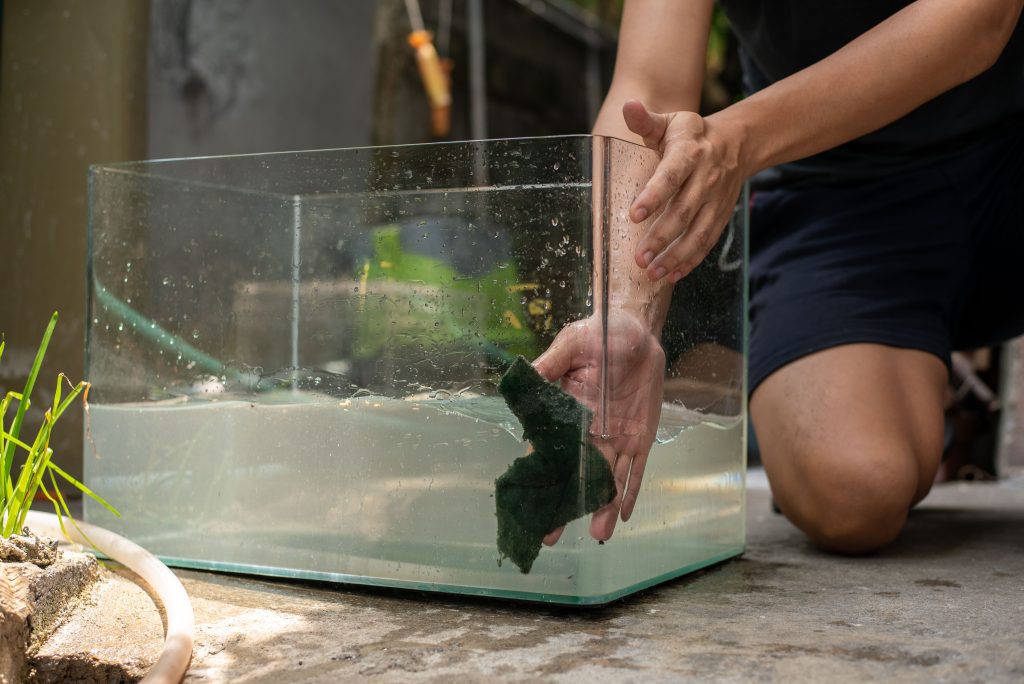
Hydrogen peroxide is pretty effective in regulating fungi that grow in fish tanks; however, it should be noted that this cleaning solution should be used sparingly for the safety of your fish. Large doses may cause harm to their health.
Fabric Stains
Other than cleaning every room in your house, hydrogen peroxide can also be used to remove stains from your clothes. This is especially helpful to families with younger kids as they often need to take care of all kinds of food or dirt stains on their children’s clothes.
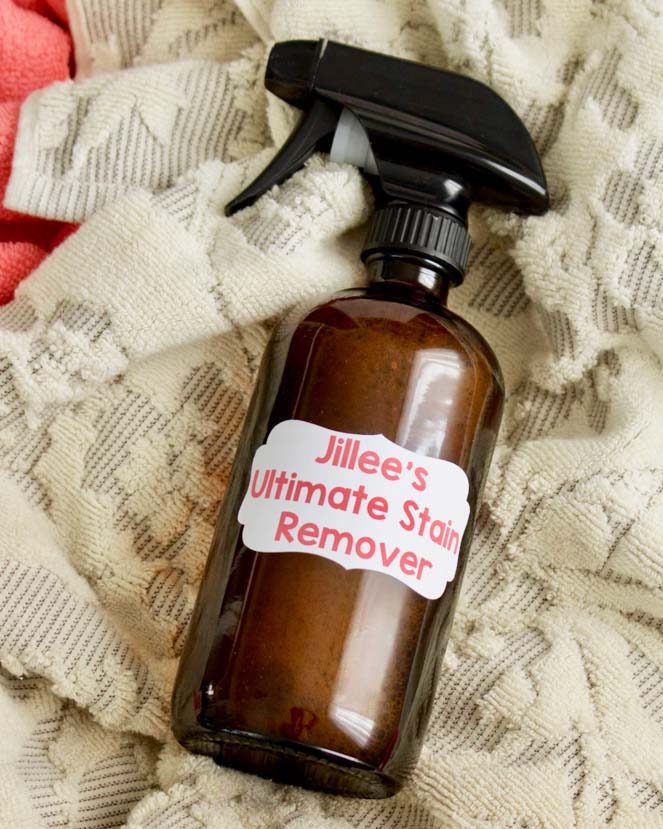
Pretreat your stained clothes by spraying some hydrogen peroxide on the stain and letting it sit for a while before throwing them in the washing machine. This trick does not only work for clothes, of course, but also on curtains, linens, and tablecloths.
Blood and Sweat Stains
Organic stains may be quite difficult to remove. Other stains like food or coffee stains can sometimes be prevented if you’re careful and mindful, but sweat and blood are pretty hard to control. We have an effective cleaning solution for you.
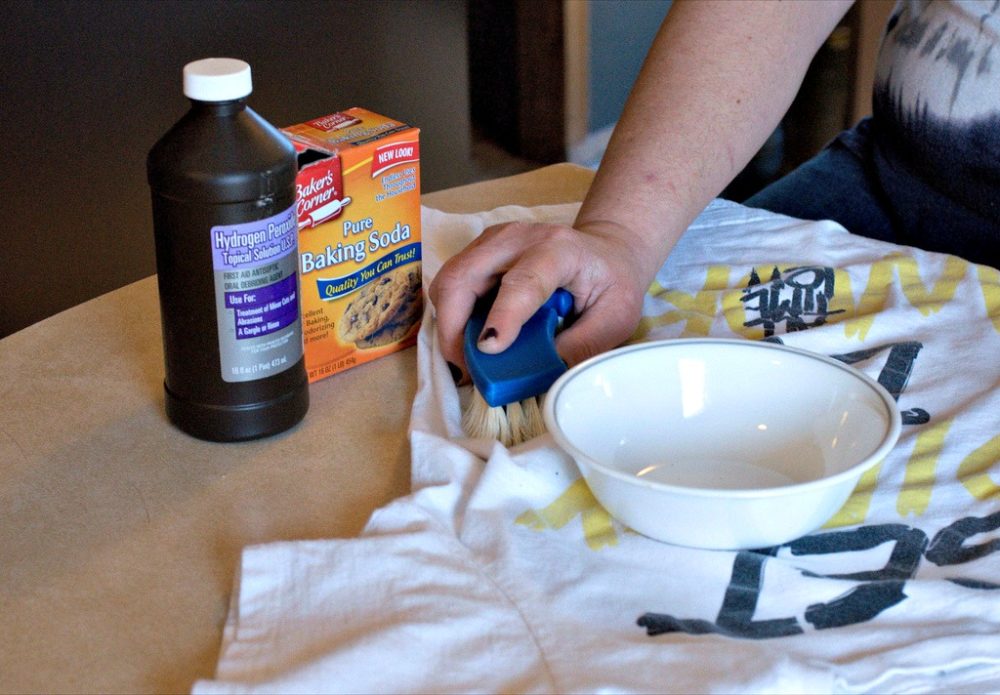
How about a hydrogen peroxide stain remover? Simply spray the stain with hydrogen peroxide and rub it in (with or without baking soda). This works best with fresh, wet stains, and it should be noted that there’s a slight chance that hydrogen peroxide may bleach dark fabrics.
Whiten Yellowed Linen
White fabric made of all-natural fibers like linen is prone to turn yellow for two main reasons. Either these materials are exposed to too much chlorine bleach, or the high heat of your dryer might be turning the linen yellow.
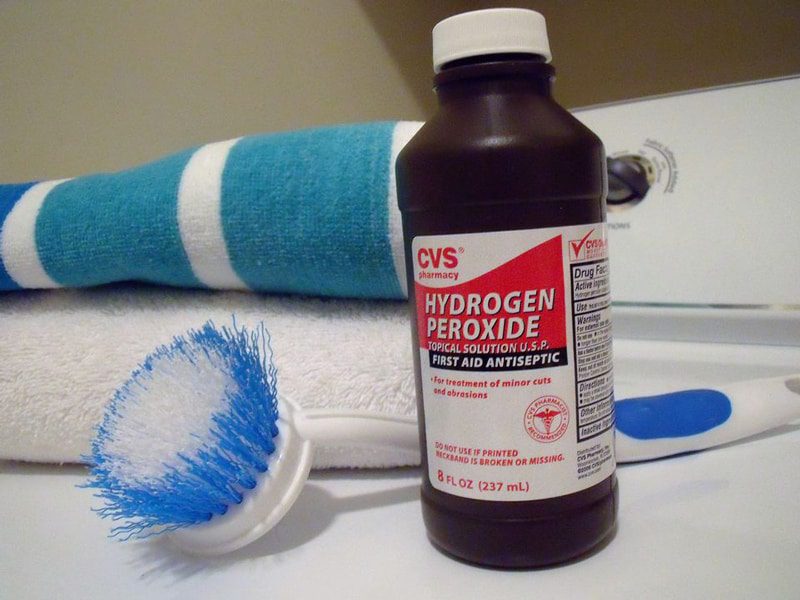
Fortunately, hydrogen peroxide can be used to return yellowed linen to its original white state; simply add two cups of hydrogen peroxide to a sink of cold water and soak the linen in the sink for around an hour. Afterward, hang them to dry.
Freshen Musty Towels
In some cases, towels develop a musty smell that won’t go away even after they were washed; the reason behind this is that there is tough mildew growing on them. Towels are soft and often moist, making the perfect breeding ground for mold and other bacteria.
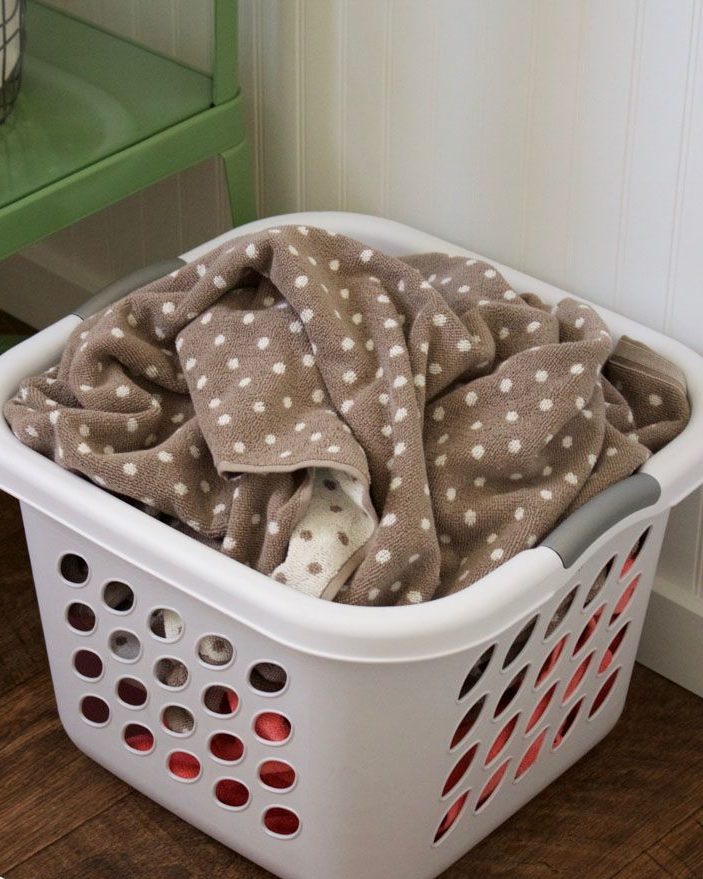
To get rid of the smells resulting from mildew and freshen your towels, add ½ cup of hydrogen peroxide and ½ cup of white vinegar to the washing machine and let your musty towels soak in it for 15 minutes before washing as per normal.
Remove Skunk Smell
Speaking of weird and unpleasant smells, skunk smell is probably the worst; doggies are most likely to be skunked, but their owners are the ones who have to bear with the smell and think of ways to get rid of it.
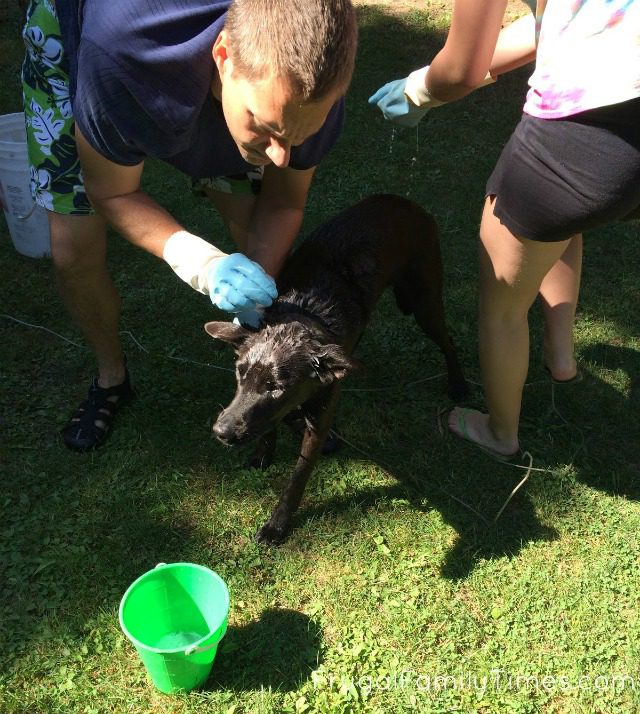
Well, here’s a simple way to get rid of skunk smells: mix one quart of hydrogen peroxide, ¼ cup of baking soda, one teaspoon of dish soap, and two quarts of warm water to make a de-skunking solution. Apply it to your pet, lather, and rinse.
Cleaning Toys
Children’s toys are filled with germs and bacteria; kids often play with them outside, in the bathtub, while eating – all in the same day. This is a natural part of childhood! It is the parents’ job to clean the toys regularly.
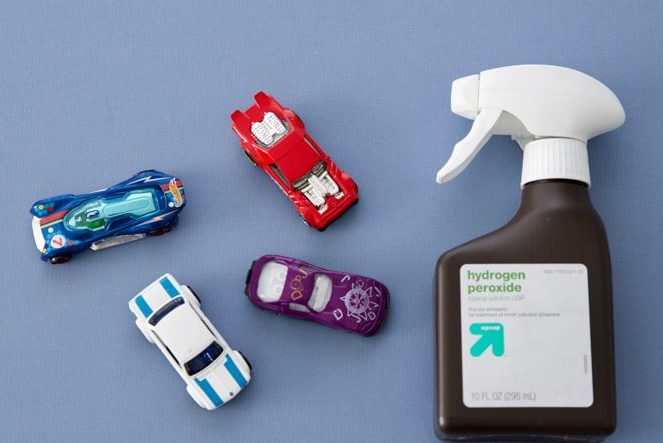
Unlike other cleaners, hydrogen peroxide won’t irritate the lungs, making it the perfect option for children’s toys. Regularly spray your child’s toys or things they constantly touch with hydrogen peroxide and wipe it down to prevent the germs from getting on their hands.
Cleaning Contact Lenses
Contact lenses come in close contact with your eyeballs which are extremely fragile and sensitive to dirt, dust, germs, and bacteria, so items like contact lenses should be cleaned carefully and periodically for the sake of keeping your eyes healthy.
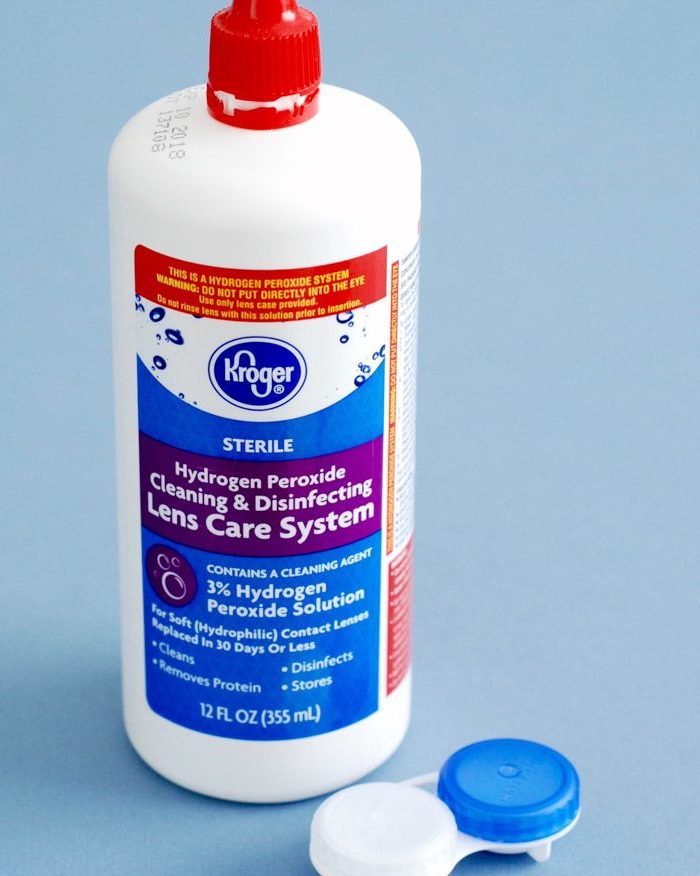
Therefore, you should choose contact lens cleaning solutions that are hydrogen peroxide-based; they prove more effective than regular non-hydrogen peroxide-based options. If you make it yourself, be careful to dilute it with quite a bit of water to avoid burning your eyes.
Sprouting Seeds
Aside from cleaning, disinfecting, and sanitizing, hydrogen peroxide can also be used to aid the sprouting of seeds. It can encourage the growth of healthy roots because of the extra oxygen molecules; oxygen helps plant roots absorb nutrients from the soil.
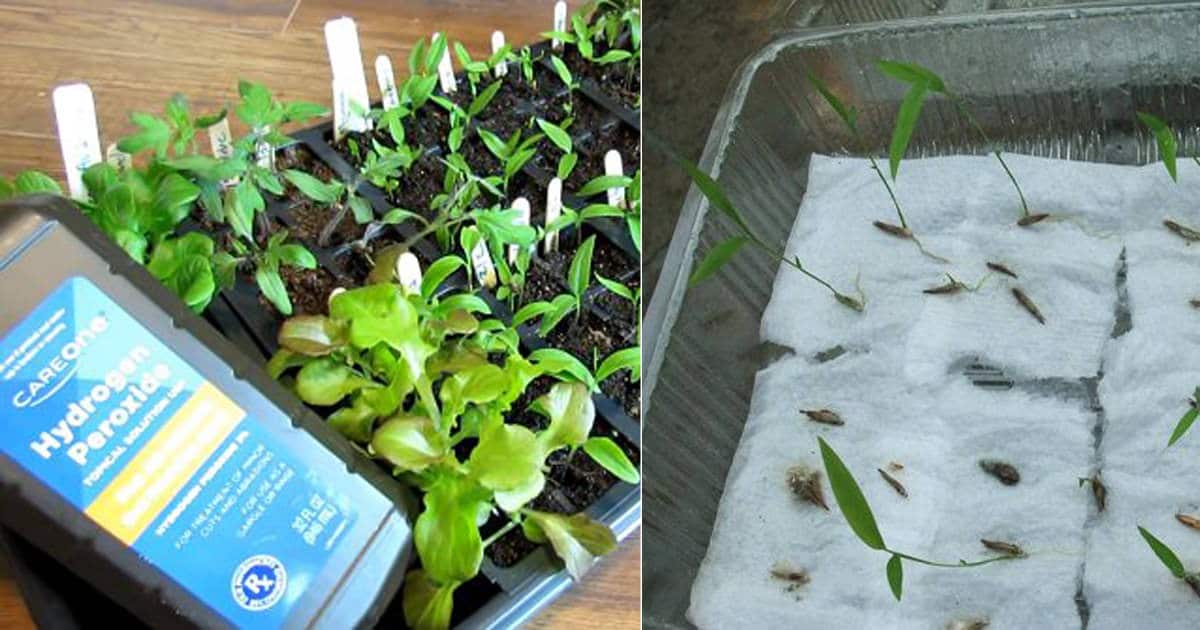
Before the seeds sprout, spritz them with hydrogen peroxide each time you remoisten them. After they’re big enough to be transferred to the ground, use a solution made of one-ounce hydrogen peroxide and one-quarter cup of water to strengthen your plant’s root system.
Keep Houseplants Healthy
Besides that, hydrogen peroxide has proven to be effective in keeping your houseplants healthy and alive; hydrogen peroxide contains properties that keeps plants free of fungus and other diseases which may cause harm to the health of your plants.
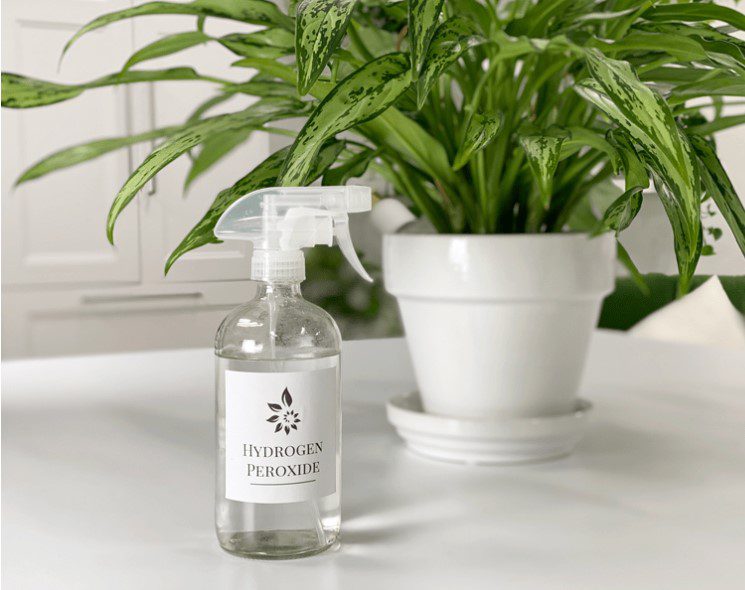
The next time you’re watering your houseplants, go ahead and add some hydrogen peroxide to the spray bottle; the plants that are sprayed with hydrogen peroxide will look healthier, and the leaves greener, than the plants that aren’t sprayed with the solution.
Keep Salad Fresh
Since hydrogen peroxide works well in keeping houseplants healthy, it would naturally work well with keeping salad fresh as well. A small amount of hydrogen peroxide will help prevent your greens from wilting and keep them fresh for a longer period.
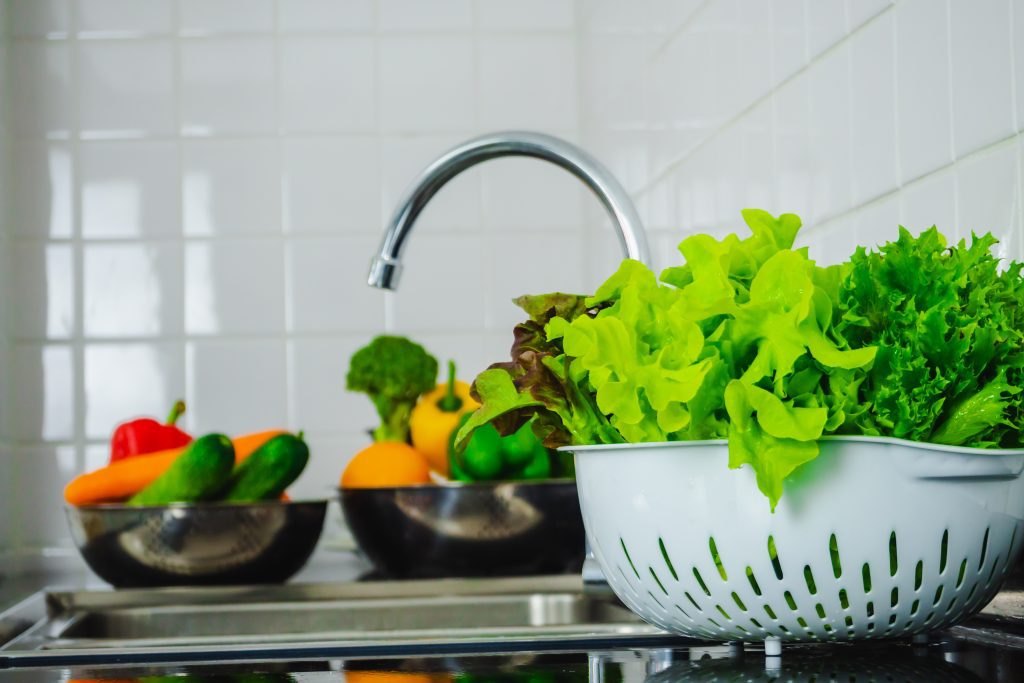
Mix ½ cup of water with one tablespoon of hydrogen peroxide in a spray bottle and spray the solution onto salad greens or other leafy greens before covering it and putting it in the refrigerator; be sure to wash the greens before consuming.
Natural Hair Highlights
Who knew that other than disinfecting, cleaning, and sanitizing, hydrogen peroxide can be used as a beauty/hair product? That’s right! It can help create subtle highlights in your hair. However, this should not be done frequently, as it may damage your hair.
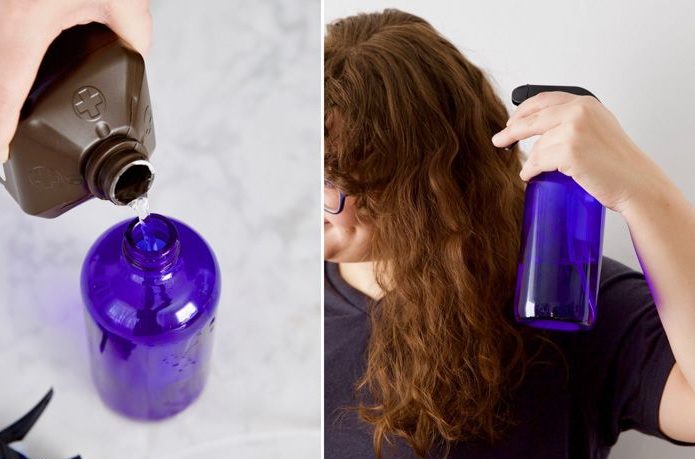
If you want subtle hair highlights, first wet your hair completely. Then, add equal parts of hydrogen peroxide along with water to a spray bottle. With the solution, spray it onto the areas of the wet hair where you want highlights.
Treat Acne
The topic of whether hydrogen peroxide can treat acne is widely controversial; it is said that dabbing hydrogen peroxide onto pimples and breakouts can help clear the skin as it can kill any acne-causing bacteria. That sounds like an easy win, right?
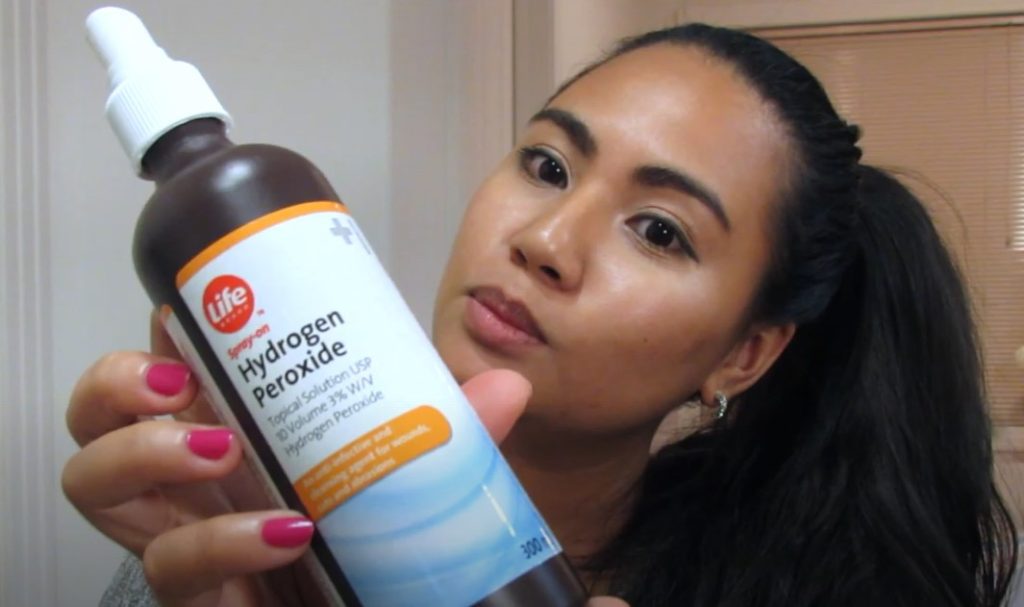
However, side effects of this acne clearing technique include irritation, blistering, and burning, so professionals often replace hydrogen peroxide with benzoyl peroxide or retinol, which in their opinion, is safer. Regardless, you should consult with a skin specialist or doctor before trying this.
Treat Canker Sores
Other than treating acne, hydrogen peroxide can also be used to treat canker sores, more commonly known as aphthous ulcers, which are small, shallow lesions that develop on the soft tissues in your mouth or the base of your gums.

To relieve yourself from the pain of canker sores, swish a tablespoon of hydrogen peroxide around your mouth for about 10 minutes; this should help disinfect the affected area, reduce inflammation, and hopefully reduce the discomfort and speed up the healing process.
Removing Ear Wax Buildup
Ear wax is formed by the combination of ear gland secretions and dead skin cells. Although ear wax has both lubricating and antibacterial properties, excessive buildup may cause a range of problems such as hearing loss, irritation, dizziness, and pain and ringing in the ears.
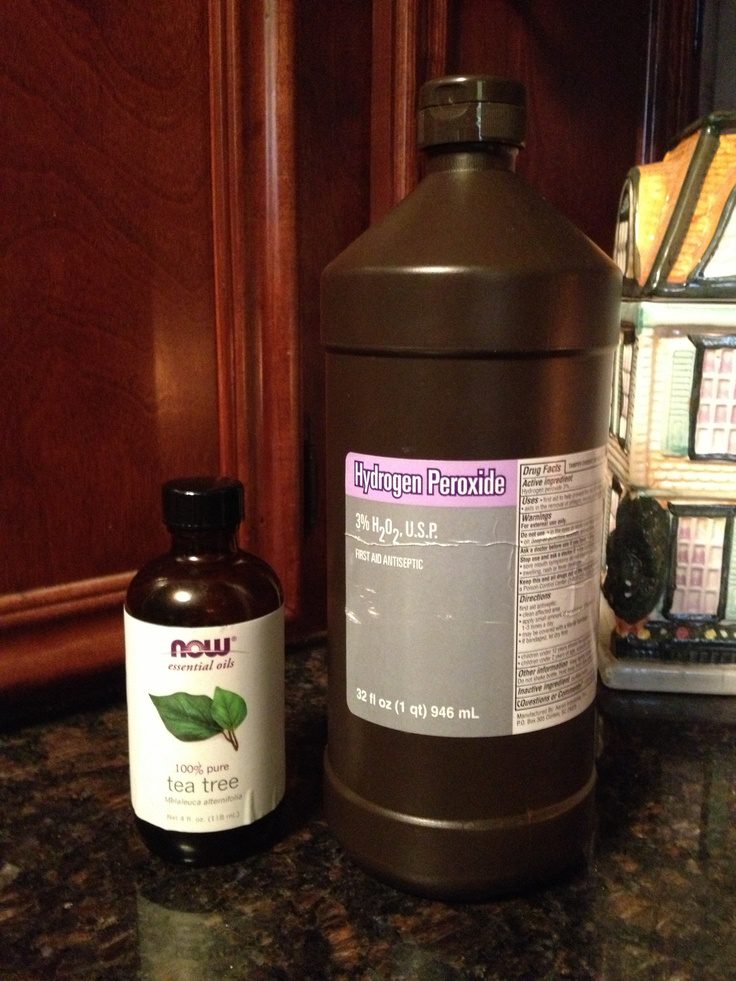
Hydrogen peroxide, along with some olive oil, (you may use tea tree oil as an alternative) can effectively remove ear wax. First, put a couple of drops of oil in the affected ear and follow with hydrogen peroxide. Rest for a few minutes. Then, remove the cleaning solution as well as wax.
Pamper Feet
It has been scientifically proven that foot soaks are beneficial to our health. It helps relieve stress, ease pain and muscle cramps, boost nerve and muscle function, and even prevent blood clots. So, go ahead and give foot soaks a try, one that involves hydrogen peroxide!
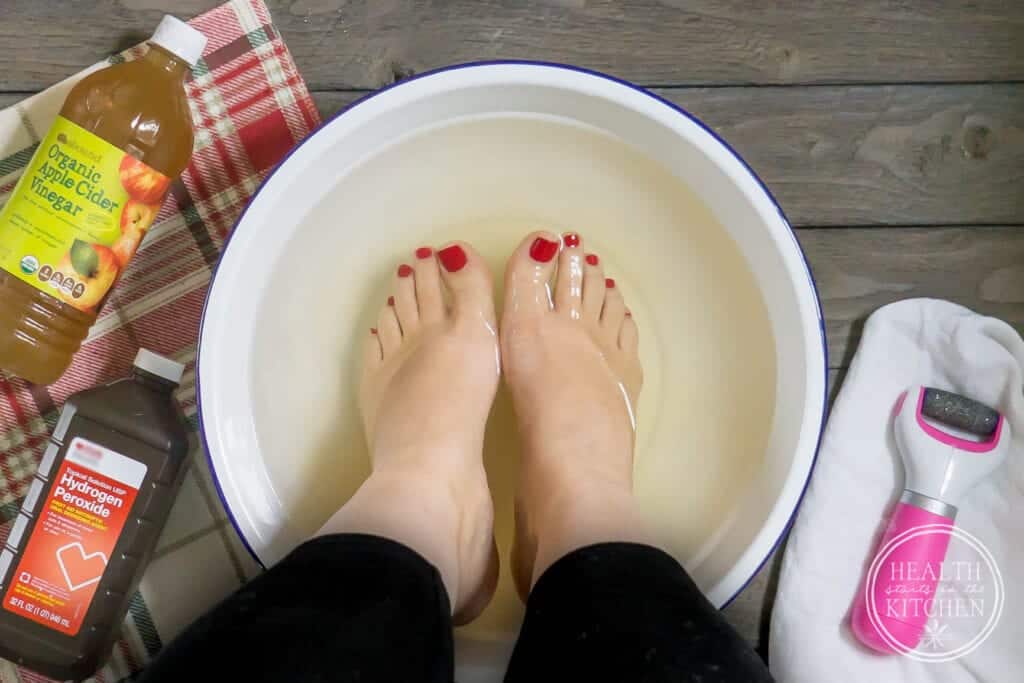
Prepare a tub or bucket that you can soak your feet in with three parts warm water and one part hydrogen peroxide and soak your feet in them; not only does this foot soak treat foot fungus, it also softens calluses and corns as well as disinfects minor cuts.
Whiten Yellowed Nails
Yellow nails can either be the result of over painting or an indication of nail fungal infection; when nails turn yellow, getting rid of it can cause quite a headache. Fortunately, hydrogen peroxide can white yellowed nails easily and effortlessly.
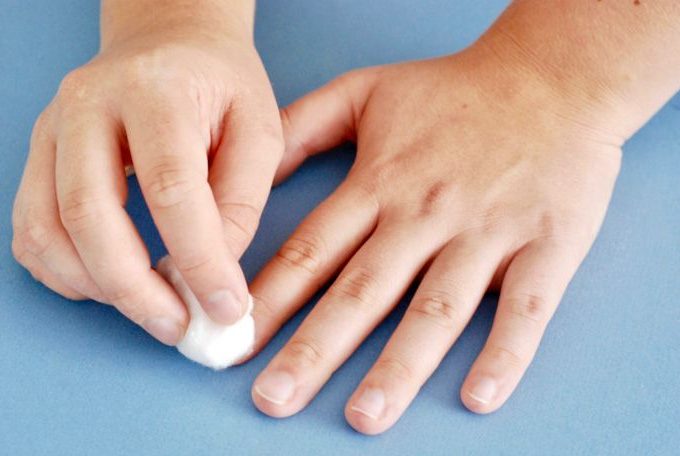
Simply soak a cotton ball in hydrogen peroxide and let it sit on the affected nails for a few minutes until the yellow stains disappear. Since hydrogen peroxide can be rather drying, be sure to apply some hand lotion or cuticle cream to moisturize the hands afterward.
When Your Dog Eats Something Bad
We have seen a few ways hydrogen peroxide can be useful in the health of your pets. How often is it that your doggies consume something that is dangerous for their health? Well, if this happens commonly, hydrogen peroxide may come in handy for you as it can help induce vomiting.
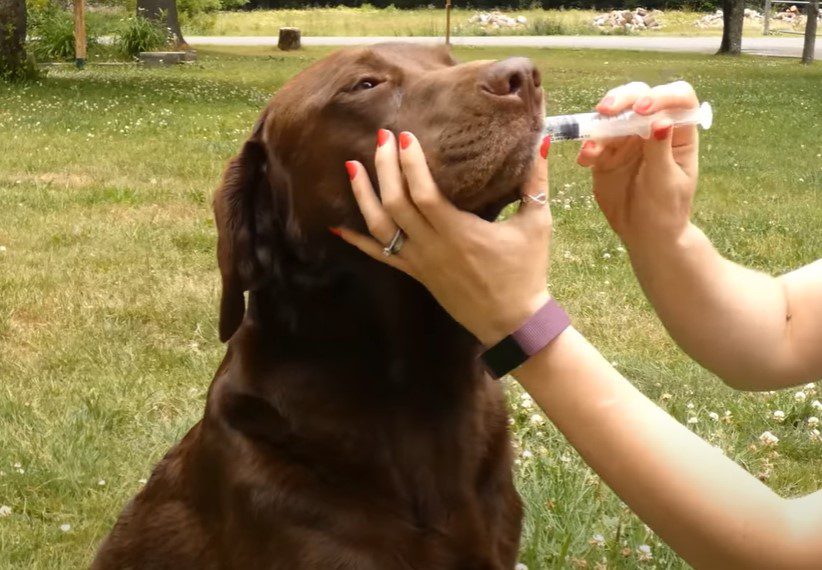
You should consult a vet about dosage before trying this to ensure that this method is safe for your fur baby. You cannot give hydrogen peroxide to your dog undiluted – they only need one teaspoon per five pounds of body weight.
Perform First Aid
Finally, the most basic and obvious use of hydrogen peroxide – performing first aid. Each household should have a first aid kit prepared in case of emergencies, and the most crucial element to any first aid kit is hydrogen peroxide.
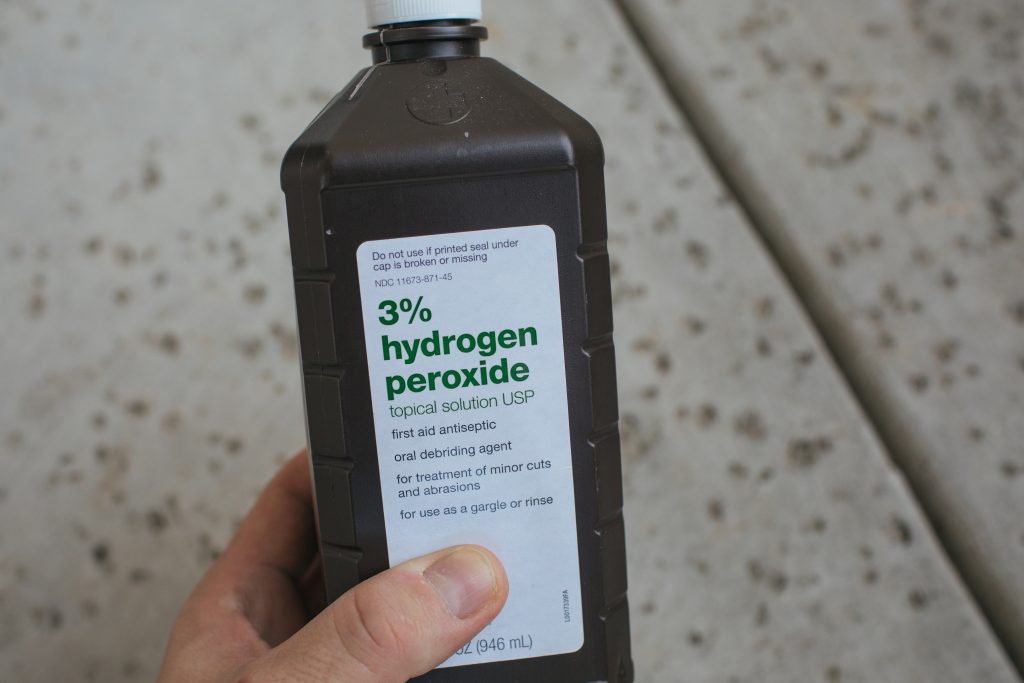
Due to the properties of hydrogen peroxide, it is effective in disinfecting wounds which is the very first step in performing any form of first aid; this particular step prevents the wound from getting infections that may wound the injury further.
